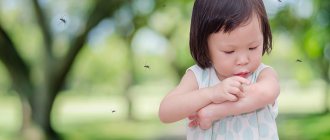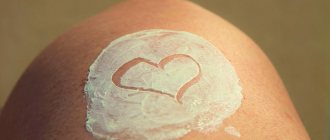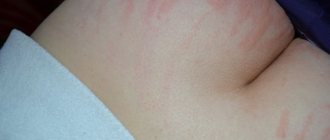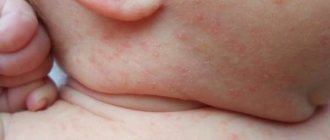What are allergies in children
Allergy is the body's hypersensitivity to any foreign substance (antigen) followed by an immune response. According to scientific data, this feature itself is not inherited, but the predisposition to it is. Children whose parents have allergies (especially if both of them or just the mother are allergic) may be more likely to develop it.
When we come into contact with an allergen, the body reacts in such a way as to block the access of “dangerous” substances, according to its data, into the blood. This is expressed in inflammatory phenomena that occur due to the release of immunoglobulin E and histamine, a hormone that regulates various functions of the body.
Histamine causes swelling of tissues, stagnation of blood in capillaries, a decrease in pressure, makes the heart beat faster - all these changes should help the body quickly deliver as many leukocytes - protective blood cells - to those areas where their presence is needed.
Excessive sensitivity of the body to a particular allergen leads to the release of excessive amounts of histamine, which is why doctors prescribe antihistamines for allergies.
It is believed that in Russia from 15 to 35% of people suffer from allergies.
What are the symptoms of allergies in children? Common manifestations of this condition include the following:
- runny nose;
- sneezing;
- cough;
- itching;
- watery eyes or dry eyes;
- labored breathing;
- chills;
- rash or redness of the skin, eczema;
- inflammation of the mucous membranes;
- Digestive problems - with food allergies.
In the case of acute allergies, life-threatening anaphylactic shock can develop, when pulmonary edema occurs, breathing is impaired and blood pressure decreases.
Clinical researches
The conducted clinical study proves the high efficiency, safety and tolerability of the product for daily skin care of children and adults with mild and moderate forms of atopic dermatitis and during remission, accompanied by a decrease in the quality of life of patients. As a result of therapy, a decrease in the activity of the inflammatory process, a decrease in dryness, itching and flaking was noted.
Clinical research has confirmed the following properties of La-Cri cream for sensitive skin:
- Removing redness;
- Skin moisturizing;
- Gentle skin care.
Based on the results of joint research, the following information is placed on product packaging: “Recommended by the St. Petersburg branch of the Union of Pediatricians of Russia.”
Sources:
- B.A. Shamov, I.G. Safiullina, A.B. Beshimova, T.B. Shamov, Differential diagnosis of atopic dermatitis, Journal of Practical Medicine, 2011
- Fokina R.A., Atopic dermatitis: stages of development of classification forms, Siberian Medical Journal, 2007
- Schneiderman Paul, Grossman Mark, Differential diagnosis in dermatology. Atlas, Publishing house: Binom, 2017
- Reken Martin, Schaller Martin, Sattler Elke, Burgdorf Walter, Atlas of Dermatology, MEDpress-inform publishing house, 2018
Photos of allergies in children
Photo album on the diseaseWhat types of allergies are there?
The list of main allergens includes:
- dust - it contains several allergens at once, from plant pollen and dust mites to epithelial scales of pets;
- pollen - allergies can also develop to pollen from domestic plants;
- pet hair and particles of their skin, as well as down and feathers;
- fungal or mold spores;
- Food. Food allergies in children are common. It is very important to take care of its prevention during the mother’s pregnancy;
- Insect bites - usually from wasps, hornets, bees, bumblebees and ants. This allergy occurs in 0.4–0.8% of the population. These and other insects produce a variety of poisons that can cause reactions ranging from hives or swelling to seizures, diarrhea, suffocation and shock. If an allergic reaction occurs, it is important to get to the hospital very quickly or give the child the necessary medications within the first hour, which should be discussed with a pediatrician in advance;
- some medications. It is usually difficult to check in advance which medications cause an allergic reaction. In addition, an allergy to a specific drug can appear at any time in life, even if a person has not previously had one;
- latex - this allergy can manifest itself in very different ways and, as a rule, develops in people who are forced to frequently wear latex gloves, for example, doctors.
Other risk factors include smoking, using a gas stove, dry pet food, household chemicals and industrial pollution. It is believed that a child living in an area where the air is polluted due to proximity to the road can cause allergies.
Symptoms of allergic reactions
- Skin rashes or irritations. Manifest in the form of redness, itching, spots, peeling. Rashes from food or contact allergies often resemble insect bites or nettle stings.
- Difficulty breathing. A runny nose, coughing, and sneezing are the most common allergic reactions to dust, pollen, and animal dander. Allergens cause irritation of the nasal or bronchial mucosa.
- Conjunctivitis. Redness, itching, and watery eyes often occur upon contact with household chemicals, cosmetics, pollen, dust, and wool.
- Difficulty in digestion. Abdominal pain, diarrhea, vomiting - a reaction to food allergens.
- Anaphylactic shock. The most dangerous manifestation of allergies. Shock can be caused by insect bites, medications, and certain foods (for example, nuts). An allergy sufferer's skin turns red, breathing becomes difficult and the heart rate increases. Loss of consciousness and convulsions are possible. You must call an ambulance immediately!
Symptoms similar to allergies can hide various diseases, so professional diagnosis is indispensable. The presence of allergies is confirmed by skin tests or blood tests. Do not delay your visit to the doctor in order to prescribe a course of treatment as soon as possible and avoid complications.
Course of allergy
- Allergies in children can develop instantly - for example, in the case of an ant bite - or over several months, as happens when it is caused by cat fur or pollen. It all depends on how often the child comes into contact with the allergen.
- Seasonal allergies occur every year in the spring, summer and fall, and mold allergies can develop if there is prolonged rain outside and humidity levels in the home have increased, leading to the growth of microorganisms.
- It is important to understand that allergies in children can come and go, and there is no exact explanation for this.
My child is allergic to milk, what should I do?
Usually, the list of childhood diseases also includes intolerance by children to milk - it would seem that the most “basic” product. Therefore, in the first year of a baby’s life, it is not recommended to consume whole cow’s milk, as it is rich in proteins and lactose.
However, sometimes a negative reaction to breast milk can be observed. Then the mother needs to follow a hypoallergenic diet and, most likely, exclude cow's milk protein. Special medicinal mixtures are created for bottle-fed babies.
An allergy to milk causes problems with the gastrointestinal tract: nausea, bloating, abnormal bowel movements, colic, regurgitation.
How to distinguish a cold from an allergy in a child
A cold goes away within 10 days at the latest, but allergies appear constantly.
Here are the obvious signs of an allergy:
- the child constantly sniffles, especially if the nasal discharge is clear and liquid, and not yellow or green and thick;
- the baby constantly sneezes, his eyes are red, wet and itchy;
- the child has dark circles under his eyes, his nose is constantly stuffy, and he breathes through his mouth;
- dry cough;
- the skin is inflamed, red and itchy.
Allergy symptoms
The clinical picture of an allergic reaction directly depends on the type of pathology and the location of the pathological process.
Manifestations of skin allergies in a child include various types of rashes:
- redness of skin areas;
- the appearance of a rash;
- peeling of the skin;
- itching
This type of allergy is most common in infancy, but can persist into adulthood.
Manifestations of allergic rhinitis and hay fever:
- impaired nasal breathing, nasal congestion;
- watery nasal discharge;
- sneezing;
- itching in the nose area;
- lacrimation.
Manifestations of allergic conjunctivitis:
- swelling and redness of the eyelids;
- redness of the whites of the eyes;
- profuse lacrimation;
- a feeling of stinging in the eyes (or a feeling of “sand”);
- photophobia.
Allergy prevention
It has been proven that hypersensitivity to a particular allergen can occur in a baby when he is still in the mother’s belly, in the second trimester of pregnancy. This means that even before its birth, the expectant mother must take precautions.
Precautionary measures:
- if she is allergic to a particular substance, she must avoid contact with it during pregnancy;
- you need to stop smoking, take medications not approved by a doctor, carefully ensure that there is no contact with allergens at work - these may include platinum salts, formaldehyde, nickel or chromium compounds, pigments, pesticides, epoxy and other phenol-formaldehyde resins, organic compounds, which include chlorine, fluorine and phosphorus;
- unbalanced diet, the presence of allergenic foods in the diet, products with chemical additives. It is best to formulate a preventive diet that does not contain potential allergens;
- minimize the number of stressful situations.
After the birth of the child you must:
1. Try to establish breastfeeding (we write about how important this is for immunity in a separate article;
2. Follow a diet (which foods can be included in it and which cannot, we tell you here;
3. Temper the baby, monitor his health, give him a strengthening massage and do gymnastics with him;
4. If the child’s parents had bronchial asthma or atopic dermatitis, as well as other allergic reactions, the baby should be examined by an allergist: the sooner the problem is identified, the more effective the treatment will be.
However, it is important to understand that the best way to treat and prevent allergies is to eliminate the factors that trigger them.
If a child is allergic to dust and feathers, in addition to treatment, hygiene rules must be followed:
- mattresses and pillows must be in special plastic covers;
- special bedding should be used;
- if the laundry is ordinary, it needs to be washed and boiled 1 – 2 times a week;
- it is important to choose pillows and blankets with synthetic filling;
- the apartment should have a minimum of upholstered furniture;
- Carpets or rugs with a strong odor should not be used;
- clean using special vacuum cleaners and carry out wet cleaning.
If your baby is sensitive to mold and mildew, you need to:
- wipe surfaces in the bathroom dry after bathing;
- wash the bathroom with special solutions once a month;
- remove steam in the kitchen using a hood;
- dry clothes in a special room, not in the room.
If your child is allergic to wool, you should:
- exclude clothing made from wool and fur;
- do not go to the zoo, circus or houses where there are animals;
- If a cat or dog previously lived in your apartment, the room must be thoroughly cleaned.
If you need to protect your baby from pollen:
- when plants bloom, windows should be closed;
- do not walk in windy weather;
- You need to be careful with soaps and shampoos containing herbal preparations.
It is also important to avoid:
- stress;
- hypothermia or overheating of the baby;
- too high humidity;
- intense physical activity;
- infectious diseases - they provoke an exacerbation of allergies.
Causes
Science and medicine have not yet made clear conclusions about why allergies can develop in children.
However, there are certain factors that contribute to the development of allergic reactions in a baby. So, for example, if during pregnancy a mother abused foods known to be allergens - for example, nuts, citrus fruits, honey, smoked meats, then it is quite possible that the newborn will have signs of allergies. If the mother refused to breastfeed or its duration was extremely short, the allergy may manifest itself in all its glory. After all, an allergy is an immune response of the body, and if the child does not receive the necessary antibodies from the mother, then the risk of developing the disease increases. It can also be triggered by a wide variety of child’s eating habits - sweets, chocolate, fruits, especially tangerines and oranges. The allergens contained in these products can cause sensitization in a child - the development of hypersensitivity to such substances. As a result of the immune response, the body reacts violently to the allergen, and when it is subsequently consumed, an allergic reaction develops. Among the numerous other reasons that can trigger the development of allergies are frequent infectious diseases, constant contact with allergens - dust, animal skin, household chemicals, including those used to care for children’s skin.1,2,4 But there is a common opinion that Allergy is inherited, but in practice it is not confirmed so often. Even if both parents suffer from allergic diseases, the risk of developing the disease in the offspring is approximately 60%.4
Features of taking an allergen test
Allergen analysis in children is necessary to identify specific immunoglobulins (causal allergens) responsible for the development of food or other allergies.
The main indications for laboratory diagnostics include:
- the need to confirm food allergies;
- the need to assess the effectiveness of diet and treatment;
- hereditary predisposition to the development of allergies;
- a history of any immediate allergic reaction (Quincke's edema, anaphylactic shock);
- confirmation of allergy to the vaccine.









